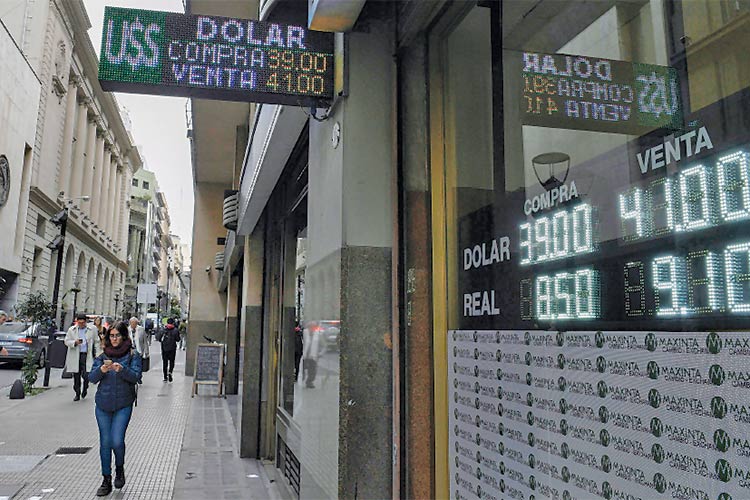Argentina’s debt creates fresh headache in election year

People walk past a foreign exchange outlet in Buenos Aires, Argentina. Agence France-Presse
The Leliq debt, denominated in pesos and auctioned daily to mostly domestic banks, helps the central bank mop up funds in the market to bolster a weak currency and bring down stubborn inflation. But with sky-high interest rates it is also raising concerns that it could become unsustainable.
The spike in the short-term government debt instrument is significant in a country where a tumbling peso, stalling growth and problems repaying debt last year led to an emergency $56 billion deal with the International Monetary Fund.
“If investors start thinking that this is a problem, then it could become a self-fulfilling prophecy,” said Carlos de Sousa, senior Latin America economist at Oxford Economics.
“Banks could be discouraged from holding Leliqs, the interest will go up further, and that may end up in the BCRA (central bank) having to rethink its monetary policy framework once again.”
A central bank spokesman said when inflation was taken into account the rise in Leliq volumes was “considerably more moderate.” Monthly inflation in January was 2.9 per cent and is expected to rise around 32 per cent this year.
The central bank auctioned around 200 billion pesos in Leliq notes on Wednesday at a four-month high average interest rate of 63.328 per cent, with net Leliq debt rising above the trillion peso mark for the first time this week, according to official bank data and traders.
In theory, if rates remained elevated, that could put the government on the line for annual interest of around 600 billion pesos or more, considering compound interest. Most analysts expect rates to drop, though they have spiked again recently.
Rates peaked at over 70 per cent in October before easing to just above 40 per cent last month as economic fears abated. However, higher-than-expected inflation and renewed fears about the peso have forced rates back up sharply over the last month.
The issue would arise if high rates created a “snowball” effect with Leliq notes, some analysts said, as the central bank issued more of the instrument to repay the debt. Leliqs set the benchmark lending rate and are a main tool to control inflation.
“The face value of Leliqs is really high now so we need to watch it closely,” said Juan Lezica, a Buenos Aires-based economist with consultancy ACM. “It starts to get a bit dangerous if it continues to grow at this rate.”
Rating agency Moody’s said on Wednesday the high rates were negative for the country’s banks because they increased loan delinquencies and stymied economic activity.
The sharp ramp-up of high-interest Leliq debt underscores how Argentina’s central bank is having to fire on all cylinders to defend the peso, which lost half its value against the dollar last year, and draw down inflation running at nearly 50 per cent.
High-interest peso debt encourages banks to keep their money in the currency, rather than moving it into safer dollars - a trend which last year pummeled the peso.
Argentine President Mauricio Macri also wants to avoid a flight from the peso at all costs, which would destabilize an already fragile economic situation and derail his plans to seek re-election when the country heads to the polls in October.
Eric Ritondale, Buenos Aires-based economist at consultancy Econviews, said if markets remained stable then the central bank should be able to turn over the rising Leliq debt, but that rates - up twenty points in the last month - were the issue.
“The amount (of Leliq) itself doesn’t worry me so much,” he said. “What worries me is that rates have gained so much again after their lows earlier this year.”
Meanwhile, most Latin American currencies rose against a softer dollar on Wednesday after data supported hopes the US Federal Reserve would be patient about raising borrowing costs in the world’s top economy.
US producer prices barely rose in February, reinforcing the Fed’s wait-and-see approach on further rate raises this year. The data aided broad risk appetite in emerging markets, which were battered in 2018 as the dollar strengthened on multiple rate hikes. “A weaker US dollar would ease global funding conditions and may work in favor of prolonging the global economic expansion,” Morgan Stanley strategists wrote in a note.
Mexico’s peso rose 0.3 per cent, half the gain local stocks saw. Data showed industrial activity in Latin America’s second-largest economy rose 0.6 per cent in January from the previous month, further supporting sentiment.
Reuters



